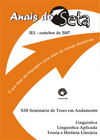AGRAMATISMO SOB O PONTO DE VISTA DA TEORIA DA ADAPTAÇÃO
Palavras-chave:
Psicolingüística, Agramatismo, Fala reduzida, ElipseResumo
RESUMO: Este estudo tem por objetivo apresentar e discutir a Teoria da Adaptação, desenvolvida por Kolk e seus colegas, e aplicável aos dados fala de sujeitos com afasia de Broca. Sob o ponto de vista deste quadro teórico, o agramatismo é o resultado de uma estratégia de adaptação do sujeito à sua lesão cerebral, que se manifesta através da fala elíptica (ou fala telegráfica, ou ainda fala reduzida) num tempo de fala maior. Uma das características desta teoria é a assunção de que a fala elíptica do sujeito agramático é bem-formada. Cada língua determina as suas regras de elipse bem-formada, e aqui serão investigadas as diferenças entre elipses bem-formadas produzidas por agramáticos holandeses (dados publicados em Kolk & Heeschen, 1992 e Kolk, 2006) e por dois sujeitos agramáticos brasileiros em situações de conversa espontânea. ABSTRACT: This study aims to present and discuss Adaptation Theory, developed by Kolk and colleagues. This theoretical framework examines agrammatic speech as an adaptation symptom the agrammatic subject performs to deal with his/ her language impairment. The outcome of agrammatic speech is the so-called telegraphic speech at a slow speech rate. One interesting feature of Adaptation Theory is to analyse agrammatic speech for its well-formedness. Every language has its own rules for well-formed ellipses, and here we investigate differences between Dutch agrammatic speakers (published in Kolk & Heeschen, 1992 and Kolk, 2006) and two Brazilian agrammatic speakers in spontaneous conversation situations.Downloads
Publicado
2008-11-05
Edição
Seção
Artigos

